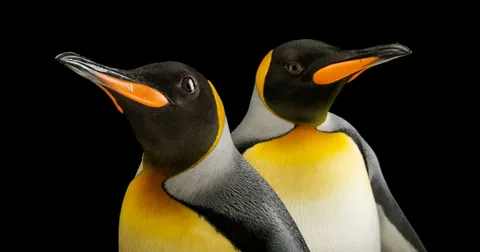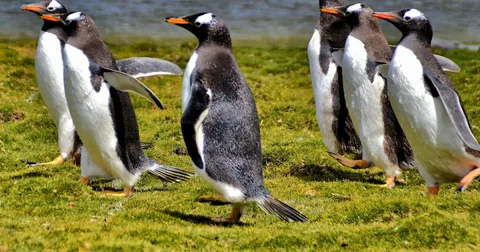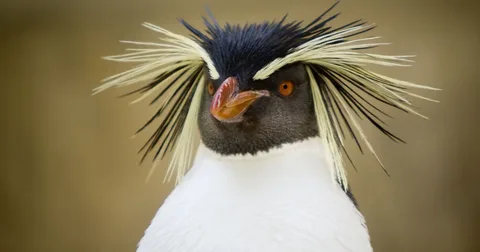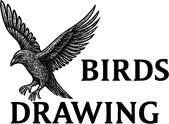Penguins: The Fascinating Flightless Birds of the Southern Hemisphere
These flightless birds are instantly recognizable by their black-and-white plumage, upright stance, and waddling walk. Penguins Birds While they can’t fly, penguins are exceptional swimmers and thrive in some of the coldest and most extreme environments on the planet. In this article, we’ll explore penguins’ world, their habitat, diet, behaviors, and conservation status.
1. Introduction to Penguins

There are 18 recognized species of penguins, ranging from the tiny Little Blue Penguin to the majestic Emperor Penguin.
Unlike most birds, penguins Birds have evolved to live in aquatic environments. Their wings have transformed into flippers, allowing them to “fly” underwater at speeds of up to 15 miles per hour. Penguins spend nearly half of their lives in the ocean, hunting for food, and the rest on land where they breed and raise their chicks.
2. Habitat and Distribution Penguins Birds

While the Emperor Penguin and Adélie Penguin do thrive in the icy wilderness of the South Pole, many other species live in warmer regions.
Cold-Climate Penguins
- Emperor Penguin (Antarctica)
- King Penguin (Subantarctic islands)
- Adélie Penguin (Antarctic coastlines)
Temperate and Tropical Penguins
- Galápagos Penguin (near the equator)
- African Penguin (South Africa and Namibia)
- Humboldt Penguin (South America)
This diversity shows how adaptable penguins are, successfully inhabiting a variety of environments from icy tundras to sandy beaches.
3. Diet and Feeding Habits

Penguins are carnivorous seabirds that primarily feed on marine life.
- Squid and Cuttlefish – preferred by larger penguins like Emperors
- Krill – tiny shrimp-like creatures that form a staple for many penguins
Penguins are expert divers, capable of reaching depths of over 500 meters in search of food. They use their streamlined bodies and powerful flippers to glide effortlessly through the water. To conserve energy, penguins can also hold their breath for several minutes while diving.
4. Social Behavior and Breeding
Penguins are highly social birds and are often seen in large colonies called rookeries, which can consist of thousands of individuals. Living in groups helps them:
- Protect against predators
- Share warmth during extreme cold
- Cooperate during chick-rearing
Breeding Season
Many species are monogamous for a breeding season, and some, like the Emperor Penguin, even pair for life.
- The female lays one or two eggs.
- Both parents take turns incubating the eggs.
- Chicks hatch after several weeks and are fed regurgitated food.
Perhaps the most incredible example of parental dedication is seen in Emperor Penguins. The males endure freezing Antarctic winters, fasting for nearly four months while keeping the egg warm on their feet until the female returns from feeding at sea.
5. Conservation and Threats

While penguins are beloved worldwide, many species face severe threats due to human activity and climate change.
Major Threats
- Global Warming – melting ice and rising sea levels affect breeding grounds.
- Overfishing – reduces the penguins’ food sources.
- Oil Spills and Pollution – contaminates their habitats and causes illness.
Conservation Efforts
Several organizations and governments have taken steps to protect penguins, including:
- Establishing marine protected areas
- Regulating commercial fishing
- Rescuing and rehabilitating injured penguins
- Raising public awareness about climate change
However, sustained global action is crucial to ensure these beautiful birds don’t disappear from our planet.
Conclusion
Penguins are not just adorable; they are a vital part of marine ecosystems. Their extraordinary adaptations, from their waterproof feathers to their cooperative parenting, make them one of nature’s most fascinating species. Yet, many penguins face growing challenges due to climate change, pollution, and human interference.
By supporting conservation efforts and protecting their habitats, we can help secure a safer future for these incredible flightless birds.
Penguin Birds in Cold Coastal Regions
Penguin birds are remarkable creatures known for their upright posture, striking coloration, and exceptional ability to thrive in icy coastal regions. These birds spend much of their lives in large colonies, where strong social bonds help them survive extremely harsh climates. Their black-and-white plumage provides natural camouflage while swimming, protecting them from predators beneath the ocean surface. Penguins rely heavily on strong flippers that allow them to glide gracefully through cold waters at incredible speeds. They feed mainly on fish, krill, and small marine animals, which they skillfully catch during deep dives. Many people admire penguins for their loyal behavior, especially during breeding seasons when parents work together to protect their young. Their presence in polar areas highlights the beauty and complexity of wildlife adapted to frozen environments.
Behavior, Diet, and Survival Abilities
The behavior of penguin birds is shaped by the need to withstand freezing temperatures while maintaining access to dependable food sources throughout the year. Their diet consists of nutrient-rich seafood that supports their high-energy lifestyle and constant movement across icy landscapes. Penguins often swim long distances during their feeding journeys, showing impressive endurance and determination in challenging conditions. Their survival abilities include excellent insulation, strong teamwork, and coordinated group actions that protect them from predators and unpredictable weather. Many species gather in tightly packed groups to preserve warmth, demonstrating their intelligence and instinctive problem-solving skills. Penguins play an important role in marine ecosystems, offering insight into environmental health and the balance of ocean life. Their unique habits and striking appearance continue to attract global interest, making them one of the most recognizable and beloved bird species worldwide.
 Birds Drawing Birds Drawing
Birds Drawing Birds Drawing




